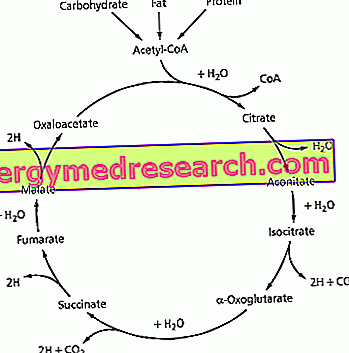The krebs cycle is also called the tricarboxylic acid cycle and uses as starting metabolite acetyl coezime A, which is obtained by the action of pyruvate dehydrogenase on the pyruvate produced by glycolysis.
ATP and reducing power are obtained from the krebs cycle; the reducing power is sent to the respiratory chain where NADH and FADH2 are oxidized to NAD + and FAD respectively: the reducing power is transferred, along the respiratory chain, to coupling systems from which further ATP is produced.
The krebs cycle is a focal point not only for glucose metabolism but also for the metabolism of fatty acids and amino acids, in fact the pyruvate which is converted to acetyl coenzyme A does not come only from the degradation of glucose: it is obtained, for example, also from the transamination of alanine (an amino acid).
About 80% of the acetyl coenzyme A that participates in the krebs cycle comes from the metabolism of fatty acids.
Acetyl coenzyme A is a thioester therefore it has a high energy content which is exploited by citrate synthase to form a new carbon-carbon bond; citrate synthase is the first enzyme in the krebs cycle.
The methyl carbon of acetyl coenzyme A willingly yields (for tautomery) a proton (becomes a carboanion) and attacks the carbonyl carbon of the oxalacetate: a high energy thioester is formed (citril coenzyme A) from which, by hydrolysis, citrate is obtained and coenzyme A is reformed. Citrate synthase is negatively modulated by the product, ie citrate and ATP: if citrate accumulates it means that this stage is faster than the others so it must slow down (citrate is a negative modulator).

Also the ATP influences the action of the citrate synthase since from the krebs cycle is obtained reducing power which is then sent to the respiratory chain from which ATP is produced; if you accumulate ATP it means that more is produced than what is needed. Slowing down the krebs cycle (the cycle slows down if one of its phases slows down), ATP production is also slowed: the negative ATP modulation is a feed-back modulation (the formation of one of the final products is modulated by regulating the speed of a stage of the process).
In the second stage of the krebs cycle, the citrate is converted into isocitrate by the action of the aconitase enzyme; the name of the enzyme derives from the fact that the citrate is first dehydrated with formation of the cis-aconitated and, subsequently, the water re-enters sticking to a different carbon from that on which it was tied before. Isocitrate is obtained without the substrate leaving the catalytic site; the aconitase is a stereospecific enzyme: it recognizes the three carboxylic centers of the citrate and this causes the citrate to remain bound to the enzyme so that the exit and the entry of the water always pass through the intermediate cis-aconitated.
In the third stage of the krebs cycle we have the first energy consideration because there is the loss of a carbon eliminated as carbon dioxide. The enzyme that catalyzes this stage is isocitrate dehydrogenase ; the substrate undergoes, first of all, a dehydrogenation: the NAD + acquires reducing power and oxalosuccinate is formed (it is an oxal derivative of succinic acid). The oxalosuccinate then undergoes the decarboxylation to α-ketoglutarate.
The enzyme isocitrate dehydrogenase has two modulation sites: a positive modulation due to ADP and a negative modulation due to ATP. The amount of ATP consumed daily is very high: ATP supplies the energy released by its hydrolysis, ADP and orthophosphate.
The total concentration of nucleosides (nitrogenous base plus sugar) and nucleotides (nucleotide plus phosphate) in an organism is almost constant: to say, therefore, that there is a lot of ATP or little ADP (or vice versa, a lot of ADP and little ATP) is the same thing; ADP is a synonym of need for energy and is, therefore, a positive modulator, whereas, ATP is a symptom of energy availability and is, therefore, a negative modulator.
CONTINUE: Part Two »



